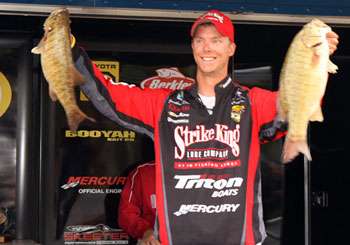
The last Bassmaster Northern Open was shortened to two days — Thursday and Saturday — by high winds. The winner, Jonathon VanDam, saw that as a blessing. Second place finisher Pete Gluszak saw it as a challenge to be overcome. Despite their different approaches, however, each man averaged over 4 pounds per fish in their quest.
Here's how they did it.
Jonathon VanDam
(1st place — 44 pounds, 14 ounces)
Jonathon VanDam, defying conventional wisdom, put together a massive sack of bass on Saturday that weighed 24 pounds, 8 ounces to claim victory at the final Bassmaster Northern Open on Lake Erie.
"I fished a drop shot over small rockpiles the first day. That went pretty well for me. When Friday was cancelled, I wasn't upset. Actually, I thought I'd gotten a break. All but two of my spots were small, so I figured a day off would give them some much needed time to replenish.
"But come Saturday morning the water was muddy and the bite was really off. I think I boated one small bass in the first hour and a half. That was frustrating because I could see big smallies hanging around the rocks with my electronics. I knew they hadn't moved.
"I finally decided that they weren't biting my drop shot because they couldn't see or find it. It just didn't make enough noise and wasn't bright enough. I tied on a Strike King Pro Series 5 crankbait in Chartreuse Sexy Shad and went to work."
That work paid off for the Kalamazoo, Mich., resident and 21-year-old nephew of legendary BASS tournament angler, Kevin VanDam. He immediately started catching bass — big tournament winning size bass.
"I ran my bait down so that it just ticked the rocks. My rocks were sitting in 13-16 feet of water on sand flats, and were pushing up towards the 8-foot mark. The Series 5 was perfect for that depth range. They killed it all day long."
VanDam threw his crankbait with a 7-foot, 10-inch Quantum KVD Tour PT Cranking Rod (medium-heavy action) and Quantum Energy PT Reel (5.1:1 gear ratio) spooled with 12-pound-test Bass Pro Shops XPS Signature Series fluorocarbon line.
"If there's anything to be learned from this event it's that conventional wisdom isn't always the way to go. Everyone says that when Lake Erie gets muddy, you need to move and get out of the wind. They say the bad weather and muddy water move the bass. But I found out that's not true, not always anyway.
"My Thursday bass were still holding on the same places on Saturday after a horrible windstorm that muddied the water on Friday. They hadn't moved at all. It was a matter of switching to a bait that they could see and find, something with vibration and color. Once I did that, I was able to catch them.
"When you're the one out on the water, you have to make your own decisions. It's not about ignoring advice or what 'everyone knows.' It's about doing what you think is right. This time it worked out for me."
Pete Gluszek
(2nd place — 42 pounds)
According to Franklinville, N.J., pro Pete Gluszek there are times when it makes sense to abandon a successful pattern.
"I caught a monster sack on Thursday in shallow water fishing the late season shad spawn, but it was in an area that was sheltered from the north wind. I knew on Saturday, with the wind blowing out of the south, that it just wouldn't produce. It was all muddied up and in a mess."
With confidence born from years of experience on the Great Lakes, Gluszek headed to another spot that was sheltered from the south wind. Unfortunately, despite its clear water and favorable conditions, it didn't produce. So he headed for deep water.
"I found some spots in 20-35 feet of water marked with rockpiles lying on sand flats. I tossed a drop shot rig over them. The bite was very finicky. The fish were holding right on the breakline. Any movement — even a foot or so — away from it and your cast was wasted.
My water clarity varied from spot to spot. In clear water I fished a Jackall Cross Tail Shad in Ayu (gold-tan-brown) or green pumpkin. In darker water I opted for a 5-inch green pumpkin Senko.
"I started out with 8-pound-test Seaguar fluorocarbon line but switched to 15-pound test after I broke off several good keepers in the rocks. I honestly think if I'd made the switch to heavier line earlier I might have won the tournament."
Gluszek fished his drop shot with a Rogue Drop Shot Spinning Rod — 7 foot, 9 inches, medium action — and a Shimano Stradic 4000 reel. He armed his Jackall plastic with a No. 1 Gamakatsu Octopus Hook but upsized to a 2/0 Gamakatsu Super Finesse Hook for his Senko. Everything was held down with a 1/2-ounce drop shot weight.




